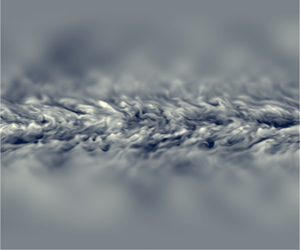Article contents
Internal gravity wave radiation from a stratified turbulent wake
Published online by Cambridge University Press: 11 February 2020
Abstract

The near-field energetics and directional properties of internal gravity waves (IGWs) radiated from the turbulent wake of a sphere towed through a linearly stratified fluid are investigated using a series numerical experiments. Simulations have been performed for an initial Reynolds number  $Re\equiv UD/\unicode[STIX]{x1D708}\in \{5\times 10^{3},10^{5},4\times 10^{5}\}$ and internal Froude number
$Re\equiv UD/\unicode[STIX]{x1D708}\in \{5\times 10^{3},10^{5},4\times 10^{5}\}$ and internal Froude number  $Fr\equiv 2U/ND\in \{4,16,64\}$, defined using body-based scales –
$Fr\equiv 2U/ND\in \{4,16,64\}$, defined using body-based scales –  $D$, the sphere diameter;
$D$, the sphere diameter;  $U$, the tow speed; and
$U$, the tow speed; and  $N$, the Brunt–Väisälä frequency. Snapshots of temporally evolving wake flow fields are sampled over the full wake evolution. The energy extracted from the wake through internal wave radiation is quantified by computing the total wave power emitted through a wake-following elliptic cylinder. The total time-integrated wave energy radiated is found to increase with
$N$, the Brunt–Väisälä frequency. Snapshots of temporally evolving wake flow fields are sampled over the full wake evolution. The energy extracted from the wake through internal wave radiation is quantified by computing the total wave power emitted through a wake-following elliptic cylinder. The total time-integrated wave energy radiated is found to increase with  $Re$ and decrease with
$Re$ and decrease with  $Fr$. The peak radiated wave power occurs at early times, near to the onset of buoyancy control, and is found to be approximately unchanged in magnitude as
$Fr$. The peak radiated wave power occurs at early times, near to the onset of buoyancy control, and is found to be approximately unchanged in magnitude as  $Re$ is increased. For the two higher
$Re$ is increased. For the two higher  $Re$ considered, at late times, IGWs continue to be emitted – accounting for a distinct increase in total radiated wave energy. The most powerful IGWs are radiated out of the wake at a wide range of angles for
$Re$ considered, at late times, IGWs continue to be emitted – accounting for a distinct increase in total radiated wave energy. The most powerful IGWs are radiated out of the wake at a wide range of angles for  $Nt<10$, at
$Nt<10$, at  $20^{\circ }{-}70^{\circ }$ to the horizontal for
$20^{\circ }{-}70^{\circ }$ to the horizontal for  $10\leqslant Nt\leqslant 25$, and nearly parallel to the horizontal late in the non-equilibrium regime of wake evolution. Internal wave radiation is found to be an important sink for wake kinetic energy after
$10\leqslant Nt\leqslant 25$, and nearly parallel to the horizontal late in the non-equilibrium regime of wake evolution. Internal wave radiation is found to be an important sink for wake kinetic energy after  $Nt=10$, suggesting wave radiation cannot be neglected when modelling stratified turbulent wakes in geophysical and ocean engineering applications.
$Nt=10$, suggesting wave radiation cannot be neglected when modelling stratified turbulent wakes in geophysical and ocean engineering applications.
- Type
- JFM Papers
- Information
- Copyright
- © The Author(s), 2020. Published by Cambridge University Press
References
- 22
- Cited by


